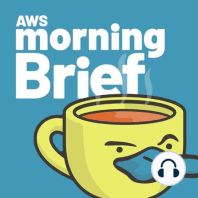11 min listen
Networking in the Cloud Fundamentals, Part 5
ratings:
Length:
16 minutes
Released:
Nov 28, 2019
Format:
Podcast episode
Description
About Corey QuinnOver the course of my career, I’ve worn many different hats in the tech world: systems administrator, systems engineer, director of technical operations, and director of DevOps, to name a few. Today, I’m a cloud economist at The Duckbill Group, the author of the weekly Last Week in AWS newsletter, and the host of two podcasts: Screaming in the Cloud and, you guessed it, AWS Morning Brief, which you’re about to listen to.TranscriptCorey: As the world spins faster, it heats up because of friction. Therefore, for the good of humanity, the AWS Global Accelerator must be turned off. Welcome once again to Networking in the Cloud, a 12 week special on the AWS Morning Brief, sponsored by ThousandEyes. Think of ThousandEyes as the Google Maps of the internet without the creepy privacy implications. Just like you wouldn't necessarily go from one place to another without checking which route was less congested during rush hour, businesses rely on ThousandEyes to see the end to end paths that their applications and services are taking, from their servers, to their end users, or between other servers, just to identify where the slow downs are, where the pile ups live, and what's causing various issues. They use ThousandEyes to see what's breaking where and then of course depend upon ThousandEyes to share that data directly with the offending providers, to shame them into accountability and get them to fix the issue. Learn more at thousandeyes.com.So, today we talk about the Global Accelerator, which is an offering from AWS that they announced at re:Invent last year. What is it? Well, when traffic passes through the internet from your computer on route to a cloud provider, or from your data center to a cloud provider, the provider has choices as to how to route that traffic in. Remember, there's no cloud provider that we're going to be talking about that doesn't have a global presence. So, they have a number of different choices.Some, such as GCP and Azure, will route that traffic directly into their networks right away, as close to the end user as possible. Others, like AWS and interestingly Alibaba, will have that traffic ride the public internet as long as possible, until it gets to the region that that traffic is aimed at, and then ingested into the provider's network. And, IBM has an interesting hybrid approach between the two of these that doesn't actually matter, because it's IBM Cloud.Now, Global Accelerator offers a slightly different option here. Because by default, traffic bound to AWS will ride the public internet until it hits the region at the end. That means that traffic is subject to latency based upon public internet congestion. It's subject to non-deterministic latency, as far as leading to... Some packets will get there faster than others, as they take different routes, so jitter becomes a concern.Global Accelerator sort of flips the behavior on its head, where instead of traveling across the entire internet until it smacks into a region, traffic now winds up landing into AWS's network far sooner, and then rides along AWS's backbone to where it needs to go. And then, it smacks into one of a number of different end points. Today, at the time of this recording, it supports application load balancers, either internal or external, network load balancers, elastic IPs and whatever you can tie those to, and of course EC2 instances, public or private. We'll mention that... The caveat about that a little later on.On the other side, to the internet, what happens is that Global Accelerator gives out two IP addresses that are Anycast. What that means is using BGP, those are generally repointed to the closest supported region to the customer. As a result, they can do a lot of changes to network architecture in completely invisible ways to the end user. It supports, for example, shifting traffic to different regions or endpoints. It can shape how that traffic winds up manifesting on the fly.So, other ways of managing t
Released:
Nov 28, 2019
Format:
Podcast episode
Titles in the series (100)
The Right to Bare Metal ARMs: AWS Morning Brief for the week of October 14th, 2019. by AWS Morning Brief
